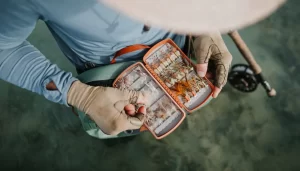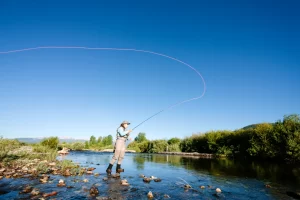Perfecting a fly-fishing tackle box is an art that evolves over time, with each angler tailoring their kit to suit personal preferences, target species, and specific fishing conditions. Crafting the ideal tackle box involves understanding the essential gear needed for a successful fly-fishing outing, from flies to tools. Here’s a guide on how to assemble a tackle box that caters to different fishing situations.
1. Choosing the Right Tackle Box
Selecting the appropriate tackle box or bag is the first step. While some anglers may prefer a traditional box, many find that a bag, backpack, or sling pack offers greater flexibility, especially for those who cover more ground while fishing. Comfort is key, as fly anglers often walk long distances. The right pack or bag should be comfortable to carry and not interfere with casting. Many modern options are specifically designed for fly fishing, with dedicated compartments for gear.
Here are a few recommended options:
- Tackle Boxes: Loadout® GoBox 15 Gear Case, Simms Fishing 20L Dry Creek Boat Bag, Exocrate Fishing Crate Bag
- Bags and Packs: Wild River Backpack With Fly Boxes, Fishpond Green River Gear Bag, Wild River Nomad
- Sling Bags: KastKing Pond Hopper, Fishpond Thunderhead Submersible Sling, Orvis Sling Pack

2. Stocking Up on Flies
The next step is selecting the right flies. The choice of flies depends on the target species and location. For most freshwater anglers, a well-rounded fly selection includes:
- Dry Flies: These ride on the surface and are used to mimic insects.
- Nymphs: These sink into the water column and imitate underwater insects.
- Streamers: These represent small baitfish and are often used with a stripping technique to make them “swim” through the water.
For tailored advice on the best flies for specific waterways, consulting with local fly shops is recommended. They can provide insights into which flies work best in the area.
3. Organizing and Protecting Flies
Once a selection of flies has been made, it’s essential to keep them organized and protected from the elements. Fly boxes are the go-to solution for this. Modern fly boxes are typically slim and efficient, allowing for easy storage without taking up too much space in a pack or tackle box. Larger flies like streamers will require more space, so choosing the right box is crucial.
Look for fly boxes that seal well to keep out moisture and securely hold flies in place. Slitted foam linings are common, though silicone inserts are gaining popularity for their durability and secure hold.
Recommended fly organizers include:
- MaximumCatch Two-Sided Fly Fishing Box
- Orvis Ultralight Foam Box
- Orvis Double-Sided Fly Box
4. Packing Tippet and Leader
Tippet and leader materials are essential components of any fly-fishing kit. The leader connects the fly line to the fly, and the tippet extends the leader’s length as it shortens from repeated use. The choice of tippet and leader size is dictated by the target species, with finer diameters providing more delicate presentations but increased risk of breaking.
5. Essential Tools to Bring
Certain tools are indispensable for a fly-fishing outing. Nippers, which resemble small nail clippers, are used to trim tippets and leaders after attaching a fly. Fishing pliers are another useful tool, often featuring cutters and used to remove flies from a fish’s mouth with minimal harm.
Suggested tools include:
- Orvis Comfy Grip Nippers
- KastKing Cutthroat 7-inch Pliers
6. Additional Accessories to Consider
Fly fishing gear can be customized with a variety of accessories to enhance the fishing experience. Items such as tippet bars, lanyards, and flotant caddies can help keep gear organized and accessible. Freshwater anglers might also want to include split shot, indicators, and flotants in their kit.
7. Relying on Trial and Error
Assembling the perfect fly-fishing tackle box is a process that involves trial and error. Experimenting with different setups, borrowing gear from others, and seeking advice from local fly shops can help refine a kit over time. The key is to continually adapt and customize the tackle box to suit personal fishing styles and the specific conditions of each outing.

Specialized Tackle Advice for Different Types of Fly Fishing
Saltwater Fly Fishing
Saltwater fly-fishing gear varies significantly depending on the location. Anglers should ensure that their gear, particularly the fly line, is suited to the water temperature. Sun protection, such as reef-safe sunscreen and sun gloves, is also important. Quality pliers that resist rust and a daily rinse of gear are essential for extending the life of saltwater fishing equipment.
Fly Fishing for Trout
For trout, most anglers use a 4-, 5-, or 6-weight rod with a corresponding line. The selection of flies and gear should be tailored to the specific fishing location and current conditions. A visit to a local fly shop for advice on the best flies and setups is highly recommended.
Fly Fishing for Bass and Warm-Water Species
Fly fishing for bass often involves using larger flies such as streamers, crayfish, or frog patterns. Anglers typically prefer stiffer rods to handle the larger flies and the aggressive strikes of bass. Including foam poppers and deer hair bass bugs in the fly box can enhance the experience, especially when bass strike on the surface.
Building a fly-fishing tackle box is a rewarding experience that evolves with each outing. By thoughtfully selecting and organizing gear, anglers can create a kit that meets their needs and enhances their time on the water.
Images/Source: WOS





